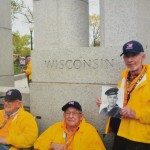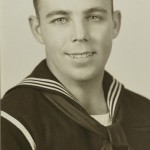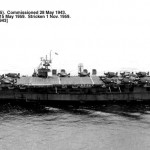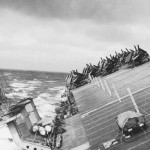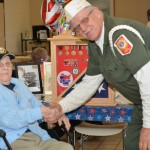Col. Paul Russell
Cowpens, named for the Battle of Cowpens of the American Revolutionary War, was launched on 17 January 1943 at the New York Shipbuilding Corporation, in Camden, New Jersey. The Mighty Moo was an 11,000-ton Independence class light aircraft carrier that served the United States Navy from 1943 to 1947. She was 623 feet long and required a crew of 1,569 to conduct combat flight operations with its primary aircraft F6F Hellcat. They called her “The Mighty Moo,” from the association of sounds in her name. It was a strange mixture of pride and derision. Only a great ship could live with such a nickname; even take pride in the element of nonsense.
The Battle of Cowpens (January 17, 1781) was a decisive victory by the Continental Army forces under Brigadier General Daniel Morgan in the Southern campaign of the American Revolutionary War over the British Army led by Colonel Banastre Tarleton. It was a turning point in the reconquest of South Carolina from the British. As it was, the Americans were encouraged to fight further, and the Loyalists and British were demoralized. Furthermore, its strategic result – the destruction of an important part of the British army in the South – was incalculable toward ending the war. Along with the British defeat at the Battle of Kings Mountain, Cowpens was a serious blow to Cornwallis, who might have defeated much of the remaining resistance in South Carolina had Tarleton won at Cowpens. Instead, the battle set in motion a series of events leading to the end of the war.
Ironically, the USS Cowpens would play a major role in ending our war with Japan during the Second World War. She was honored with a parking spot next to the USS Missouri in Tokyo Bay on September 2, 1945 when Japan signed the Potsdam Declaration. This ship and her crew were resilient and all highly decorated for their naval combat achievements. One of her crew members was Merrill native William “Bill” Illgen.
After serving some time with friends in F Battery, 120th Field Artillery, in Merrill, Bill accepted an offer from the navy to sail on a ship. His initial tour of duty was on a combat cargo ship – USS Capella, named after the brightest star in the constellation Auriga. Bill recalled the numerous small boat attacks they repelled during his initial combat se
rvice in the South Pacific. The Japanese would sneak their boats under the cover of darkness alongside the Capella looking to raid them of supplies. He shared in vivid detail how the enemy would climb the cargo nets attempting to board and on several occasions hand to hand combat broke out on deck.
Veterans were promoted to duty on larger ships and Bill was promoted to aviation machinist mate on the USS Cowpens. “Hook release man” as they were named, was one of the most dangerous jobs on the aircraft carrier. To begin with you were constantly around running aircraft on a very small landing deck. Secondly, the cables used to launch and recover the planes were dangerous, constantly causing leg and hand injuries. Lastly, you had to protect yourself from Japanese aircraft bombing, strafing the deck and torpedo bombers trying to sink you at sea. In today’s military, that would earn you hazardous duty pay!
Bill and his mates would launch and recover 25-30 aircraft sorties per day. He told of numerous incidents of cables breaking, aircraft fires, crashes and deck bombings. One of the worst occurred on the afternoon of December 4, 1944 when a damaged fighter from the USS Lexington attempted an emergency landing. The fighter crashed and fire broke out on deck. Bill rushed to the burning plane, unbuckled the pilot and got him out on the wing where other sailors carried him to safety. The pilot survived but three crew were killed and many injured or burned. Many of these sailors were Bill’s friends and he along with the rest of the crew were devastated. After the at-sea burial for those killed, Bill and some of his shipmates were ordered to a couple weeks off at one of the respite islands (PTSD) the navy operated. His daughter Sandy recalls her mother telling stories of his nightmares after the war.
Bill said, “You were fighting for your friends and ship. War is horrible, I don’t care whose side you were on or where you were. You did it or you died.”
So true coming from a man who knows and has history to back him up. Unique circumstances serving on a naval ship in World War II that I believe made the duty more difficult and challenging: Planes that didn’t return from missions and burials at sea created vacant bunks and chairs in the mess hall.
Personnel replacement lagged in the navy for obvious reasons and those serving paid some of that price.
Aviation Machinist Mate 3rd Class William Illgen came back to Merrill after the war alone like so many before and after, there was no parade, fanfare or celebration. Bill was an elder for WW II veterans having married Winifred Lucille Perry, daughter of James Walter (JW) Perry, in 1939. He was 25 when he entered WWII and earned 14 awards and decorations for his service. Bill and his fellow vets would gather at the Merrill VFW to socialize, have drinks and dinner. He went on to work at Clark and Pure Oil companies as a road supervisor. When he lived in Rhinelander, he managed the Rhinelander Country Club. For the time he and his family lived in Clearwater, Florida, he managed the Clearwater Beach Hotel.
Bill grew up without a father but never made any excuses about it and persevered like he did for 27 months in combat. What followed the war was what every man wanted, work and family. He was successful in both and described by his loving family as honest, loyal, compassionate and hard working.
What I found in this hero in the many hours I spent with him was a resilient survivor, like his ship, the USS Cowpens. Similar to the other men and women from his generation, no excuses, make something out of nothing, love your family and country. If you wish to hear a true story from a true hero, stop and visit Bill at Mount View Health Care Center (Garden side Crossing) in Wausau.
Editors note: Paul Russell is a veteran of Afghanistan and served 31 years total in the Military. He received historical research support from Mike Weix and photography from Leah Duley (Woller).

